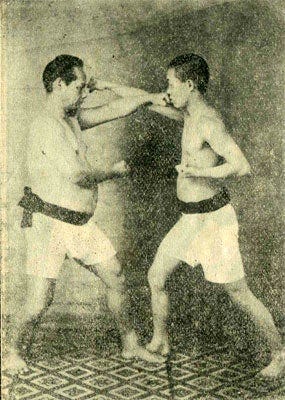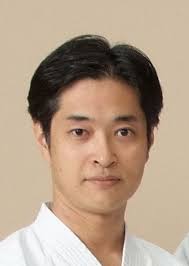There’s a saying, “There’s no first move in karate.” It was popularized by Funakoshi Gichin, so some people may mistake it for Funakoshi Sensei’s phrase, but it is actually a phrase that existed previously.
The meaning of this phrase is often interpreted as “you must not attack first” or “you must not make a move until the enemy attacks.” But is that really what it means? In fact, Asato Ankō explained this phrase:
Tactical Methods
The old saying, “There is no first move in karate,” must have been an educational admonition to young men and boys to teach them to receive and not to strike. If not, it would be inconsistent with today’s tactics. This is because, as they say, “preemptive power,” the control over (the enemy’s) ki (spirit) is a strategic method that has great power. It is also said (in swordsmanship) that if you cannot control Sen no Sen (“first of first,” or initiative attack), then you must control Go no Sen (“first of second,” or reactive attack). Applying these to karate, it means that when the enemy takes control of Sen (first), you should defend (the enemy’s attack) and at the same time counterattack. (note 1)
The quote may be a little difficult to understand because it’s old Japanese. In short, the phrase “There is no first move in karate” doesn’t mean that you shouldn’t attack before your enemy. The purpose of this phrase is to caution young people not to use karate to unreasonably use violence against others.
In a real fight, it’s important to attack before the enemy. This is the same meaning as “Sen no Sen” (preemptive attack) in swordsmanship. And if “Sen no Sen” is not possible, then Go no Sen (reactive attack) should be done i.e. immediately execute the counter attack. In karate, strike back as soon as you receive the enemy’s strike. (note 2)
Thus, Asato explains the importance of attacking first, and if that is not possible, he says to strike immediately while blocking the enemy’s attack. This is the idea of Kōbō Ittai (attack and defense as one), and technically, it is called “tsuki-uke.”

Regarding the misunderstanding of “There is no first move in karate,” Motobu Chōki stated the same tactical method as Asato in his book “My Art and Skill of Karate” (1932).
My Art and Skill of Karate (Ryukyu Bugei – Ancient Martial Arts of the Ryukyu Islands)
The book “My Art and Skill of Karate” presents the technical knowledge and original accounts imparted by famed Okinawa…
Thus, from the Taishō era (1912–1926) to the early Shōwa era (1926–1989), this misunderstanding was pointed out by both, Asato Ankō and Motobu Chōki. Unfortunately, not only was it never corrected, but on the contrary, it spread even more. Furthermore, as a “proof” of this misunderstanding, one often hears today the explanation that “all kata begin with uke (receiving) is the evidence for it.”
As I mentioned earlier in my article “Fixing the Terms and Concepts of Karate,” in kata, a seemingly uke is not necessarily a real uke. It may be a strike. It is also possible that a seemingly “strike” technique is not a strike but is actually a tuitī. This is how the techniques were understood in the old days of karate. In other words, the terms and techniques of karate were not fixed, but understood in a fluid way. This is probably the way of thinking that Matsumura Sōkon and other karate masters of the past achieved.
Note 1: “Okinawa no Bugi” (Ryūkyū Shinpō, January 19, 1914) written by Shōtō [=Funakoshi Gichin] about stories told by Asato Ankō.
Note 2: Sen no sen and go no sen are interpreted differently by different martial artists, but this article follows Asato’s interpretation.
The original Japanese was posted on May 14, 2020 on Ameba, and the English translation was posted on May 16, 2020.
Thank you for reading my story. If you would like, please follow me.
Written by:

Thank you for reading my story. If you would like, please follow me.
Shihan, Motobu Kenpō 7th dan, Motobu Udundī 7th dan. Discusses the history of karate and martial arts, and introduces Japanese culture and history.
